This article dives into some effective pairing strategies in Applied Behavior Analysis (ABA) therapy, aimed at boosting engagement and therapeutic outcomes for young individuals. By weaving enjoyable activities, preferred items, and consistent reinforcement into therapy sessions, clinicians can build positive relationships. This not only helps reduce anxiety but also significantly enhances skill acquisition and participation during treatment.
Let’s explore this together! Imagine a therapy session where your child is excited about the activities ahead. By integrating their favorite things, it creates a welcoming environment that encourages them to engage more fully. It’s all about fostering connections and making the experience enjoyable, which can lead to amazing progress. We’re here to help you every step of the way!
The journey of therapy for children with autism can often feel daunting for both the young individuals and their families. But guess what? Innovative strategies, like pairing ABA examples, are reshaping the landscape of Applied Behavior Analysis. These strategies make sessions not only effective but also enjoyable!
In this article, we’ll dive into nine impactful pairing strategies that enhance therapy engagement. You’ll discover how personalized approaches can truly transform the therapeutic experience. So, what happens when traditional methods fall short? And how can these fresh techniques bridge the gap to foster deeper connections and better outcomes? Let’s explore this together!
At Rori Behavioral Innovations Inc., we truly believe in the power of personalized pairing ABA example strategies in our treatment. By recognizing each young person's unique likes and interests, our clinicians can craft treatment sessions that are not just effective but also fun! This tailored approach helps to build a strong therapist-client relationship, which is so important for successful learning and behavior change.
In those initial treatment sessions, we focus on enjoyable activities with minimal demands—think playing with favorite toys! This creates a fun and inviting atmosphere that encourages active participation and boosts learning outcomes. Research shows that when young individuals associate their counselor with positive experiences, their motivation and involvement during sessions really soar, leading to better overall outcomes in their treatment journey.
The pairing ABA example is a key element of ABA treatment that lays the groundwork for successful intervention. Remember, it’s an ongoing process that requires continuous effort to keep that positive relationship thriving throughout the journey. Let’s explore this together and see how we can make a difference!
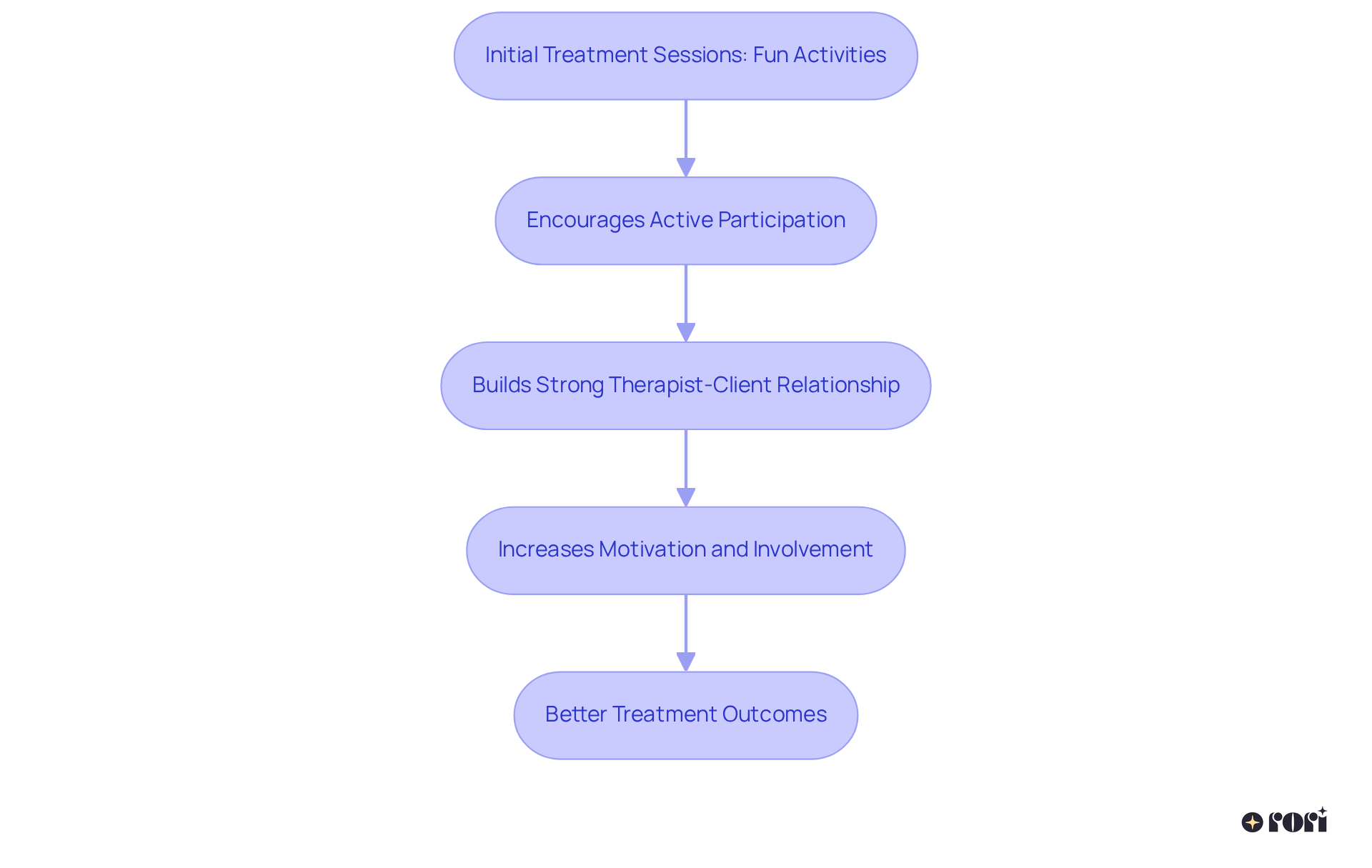
Presession pairing is all about having fun with your little one before the formal treatment session starts. This approach helps create a positive bond between the therapist and your child, making it more likely that they will engage during the pairing ABA example.
Think of activities like:
By building this rapport, therapists can help ease any anxiety or resistance, setting the stage for a more productive session. Let’s explore this together!
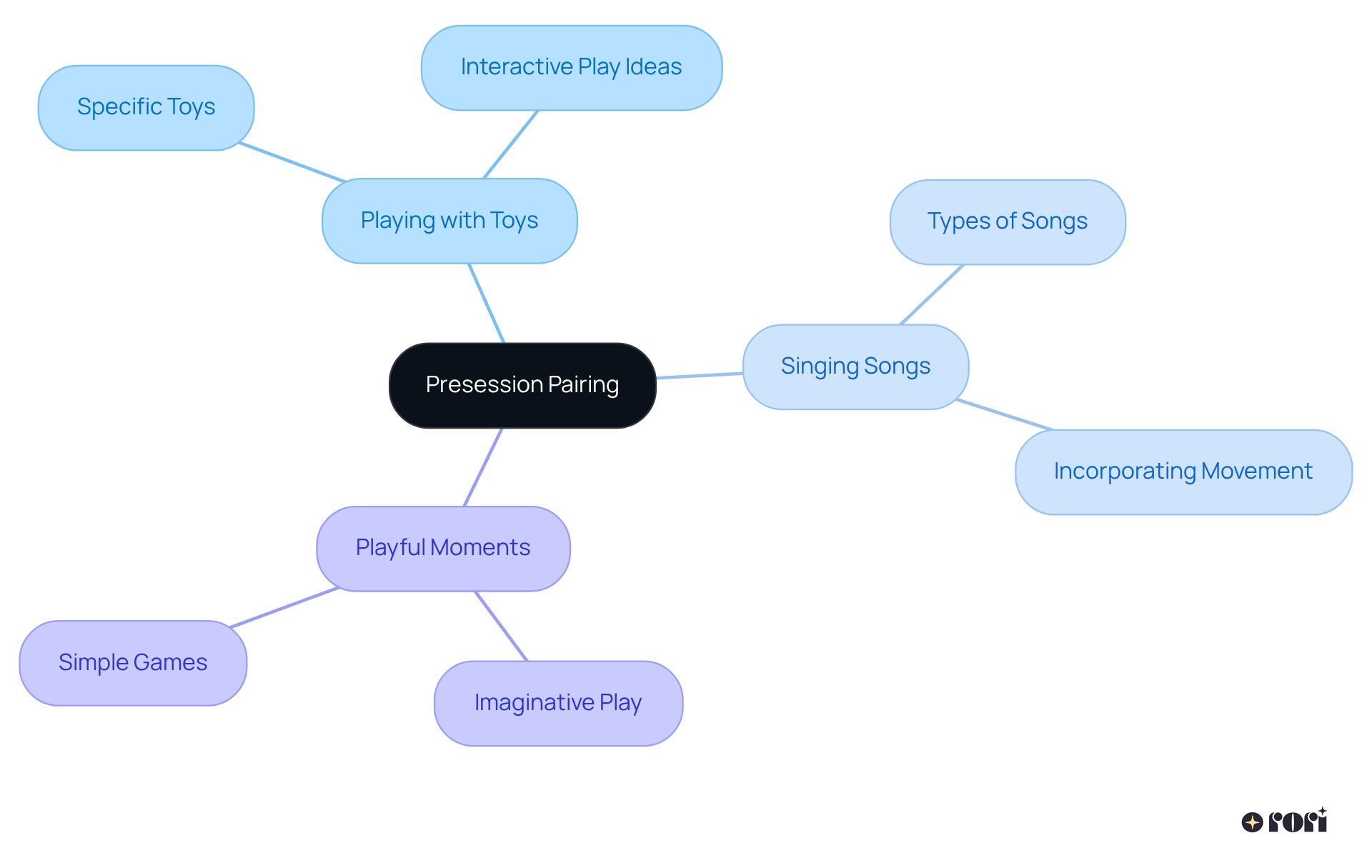
Play-based pairing is such a fun and engaging way to tap into young people's natural love for play, making therapy more effective! By bringing games, toys, and playful activities into sessions, therapists create a relaxed and enjoyable atmosphere that really captures kids' interest. This approach doesn’t just make therapy feel less like a chore; it also encourages important skill development in a fun setting. For instance, using board games and interactive play can help teach social skills and communication, allowing kids to practice these talents in a nurturing environment.
Did you know that play can significantly boost social interactions, communication skills, and behavior management for individuals with autism? Play-based ABA intervention cleverly combines structured techniques like Discrete Trial Training (DTT) and Natural Environment Teaching (NET) with playful activities. This ensures that learning is not just effective but also enjoyable! Techniques like incidental teaching during play make the learning process seamless and engaging, capitalizing on natural opportunities to reinforce skills.
What’s great about play is its flexibility! Therapists can easily adapt activities to meet each child's unique developmental needs, fostering intrinsic motivation and deeper learning. Celebrating small victories during play can really lift a young person's self-esteem and boost their motivation to engage in treatment. Plus, parents can help by creating a fun environment at home with toys and activities tailored to their child's interests, reinforcing the skills developed during therapy sessions.
Ultimately, the pairing ABA example in play-based treatment transforms the experience into a dynamic and enjoyable one, significantly enhancing involvement and skill acquisition for kids with autism. Let’s explore this together and see how we can support our little ones on their learning journeys!
Positive reinforcement is a key part of Applied Behavior Analysis (ABA) therapy. It’s all about providing rewards or incentives to encourage those desired behaviors. Think of it as giving verbal praise, tokens, or access to fun activities. When we consistently reinforce positive actions, we not only boost those behaviors but also strengthen the bond between the young person and their therapist. For instance, picture a young person who just completed a task—immediate praise or a small reward can really light up their motivation for future sessions!
Research shows that using systematic reinforcement strategies can cut down problem behaviors by up to 65% in family settings. That’s pretty impressive, right? This highlights how effective rewards can be in nurturing positive behavior change. Plus, the Behavior Analyst Certification Board emphasizes that interventions should focus on teaching new skills rather than just reducing unwanted behaviors. This approach really underscores the importance of positivity in treatment.
By weaving incentives into the treatment process, practitioners can create a more interactive and nurturing environment. This ultimately leads to better outcomes for youngsters with autism. And let’s not forget about technology! Incorporating tech into ABA treatment helps enhance the consistency and effectiveness of reinforcement strategies. This means more tailored and responsive interventions for each child. Let’s explore this together and see how we can make a difference!
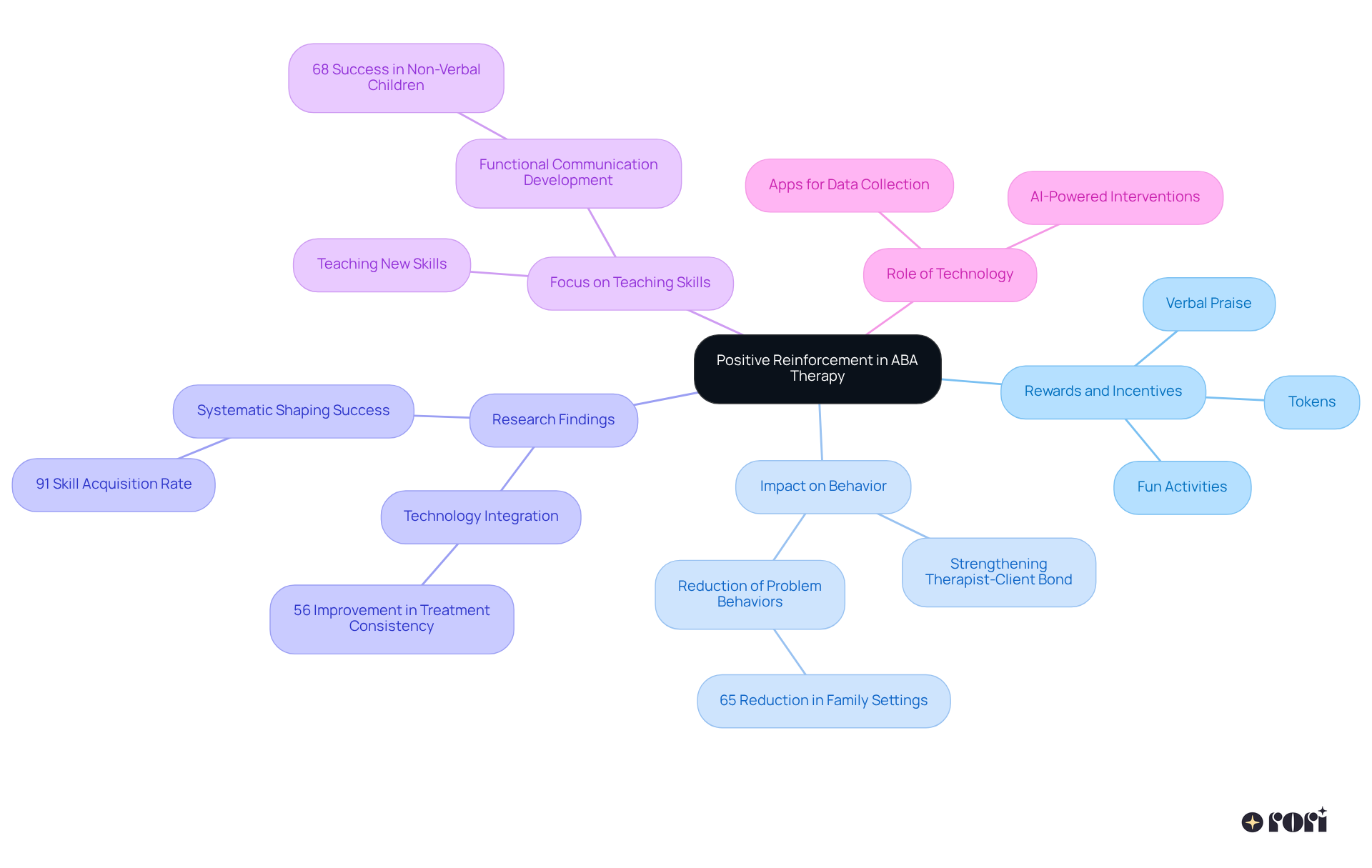
The pairing ABA example of preferred items is a fantastic strategy in ABA practices! It’s all about bringing a young person’s favorite toys, snacks, or activities into sessions to create a more engaging atmosphere. By discovering what excites the child—like dinosaurs, art supplies, or specific games—therapists can seamlessly integrate these interests into therapeutic activities. This not only boosts motivation but also makes participation feel more enjoyable.
Imagine using dinosaur-themed games during learning! It’s a great way to make the process fun while fostering a positive connection with therapy. Research shows that when kids engage with their favorite items, they often display increased motivation and improved behavioral outcomes. In fact, clients exposed to motivational statements during sessions see a 30% rise in positive behaviors!
The pairing ABA example demonstrates how this approach does wonders for enhancing engagement and helps develop essential skills in a fun, relatable way. By using preferred items, sessions transform into enjoyable experiences, leading to more impactful interventions and lasting progress. At Rori Behavioral Innovations Inc., we’re committed to making ABA support accessible and effective. Let’s explore how these strategies can empower families to support their children’s journey together!
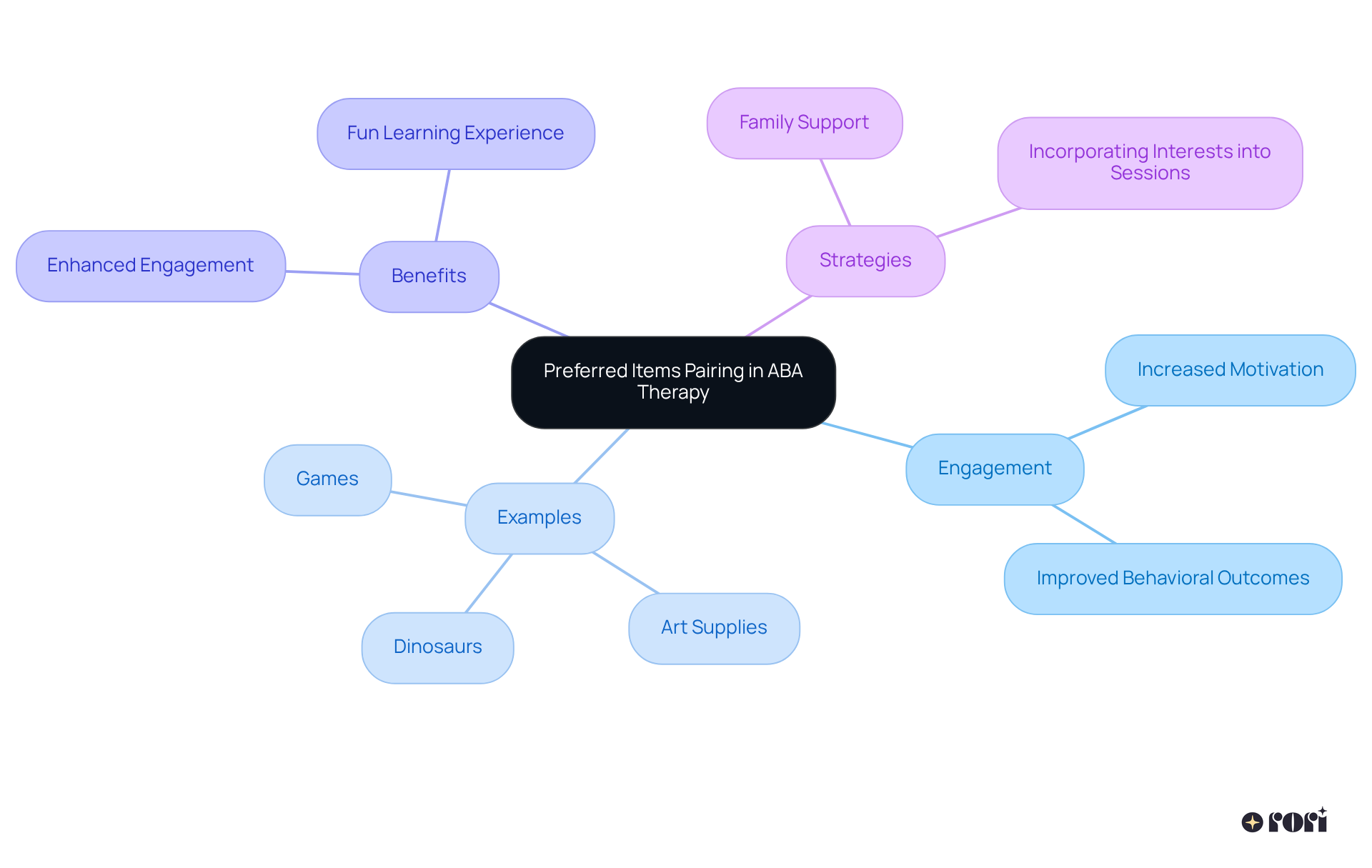
Social interaction pairing is such a valuable approach in autism therapy! It opens up opportunities for young people to connect with their peers during therapeutic sessions. By incorporating group activities and peer modeling, therapists can create environments where kids practice essential social skills in a supportive setting.
Think about structured playdates and collaborative games—these not only encourage communication, sharing, and teamwork but also help foster a sense of belonging and community among participants. Isn’t that wonderful? Studies show that children with autism who engage in peer-mediated interventions often see significant improvements in their social skills, enhancing both their verbal and non-verbal communication abilities.
Plus, using positive reinforcement during these interactions can really boost self-esteem and emotional regulation, leading to a richer therapeutic experience. It’s impressive to note that 90% of individuals show remarkable improvement when caregivers are actively involved in ABA interventions. This really underscores the importance of family participation!
By implementing a pairing ABA example in interventions, we not only enhance skill development but also nurture empathy and acceptance, which are crucial for success. As Dr. Elizabeth Laugeson highlights, meaningful friendships are essential for development, showcasing just how important peer relationships are in treatment. Let’s explore this together and see how we can support our kids in making those connections!
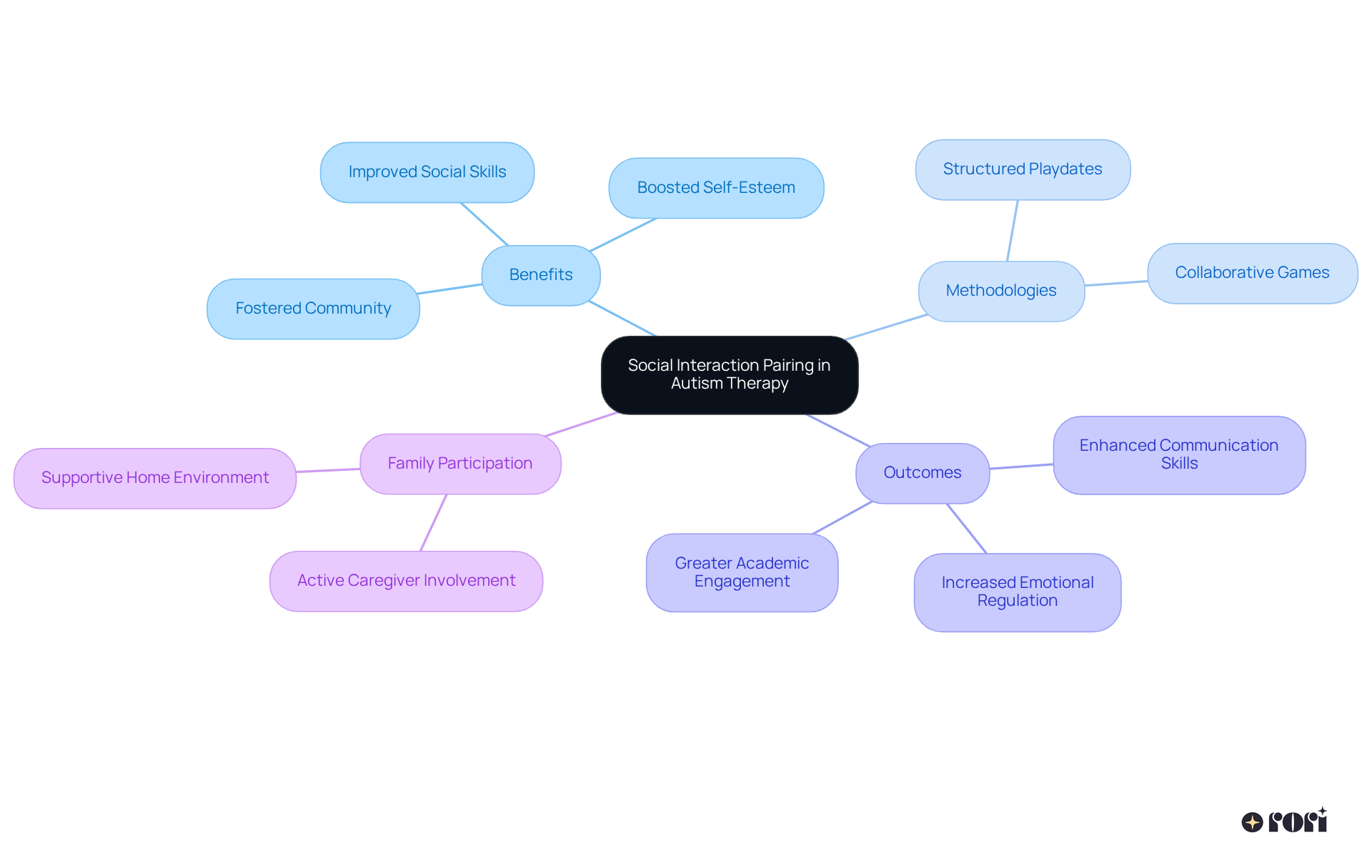
Consistency in the pairing ABA example is all about using familiar items, activities, and reinforcement strategies during sessions. This approach is so important because it helps young individuals feel secure and comfortable in the therapeutic setting. When things are predictable, it really helps reduce anxiety, building a trusting bond between the therapist and the child. This connection encourages active participation in treatment sessions.
For instance, when we consistently use the same rewards or activities, kids can look forward to positive experiences, which boosts their engagement. Research shows that having organized routines and consistent interactions can lead to better emotional stability. This stability allows young individuals to focus more during sessions.
Moreover, keeping things consistent not only helps with skill acquisition but also improves overall treatment outcomes. Kids are more likely to apply what they've learned in different environments. Finishing ABA services as planned maximizes the benefits for families, highlighting the financial impact of regular attendance.
Structured routines also make transitions between activities smoother, further supporting engagement. By creating a stable and predictable environment, therapists can really enhance the effectiveness of ABA interventions. This ultimately leads to greater independence and a better quality of life for children with autism. As Rori Behavioral Innovations Inc. says, 'Long-term, consistent treatment can lead to significant improvements in quality of life.'
And let’s not forget, training for parents and caregivers is essential! Strengthening skills at home ensures consistency in ABA treatment, showcasing the vital role families play in this journey. Together, we can make a real difference—let’s explore this together!
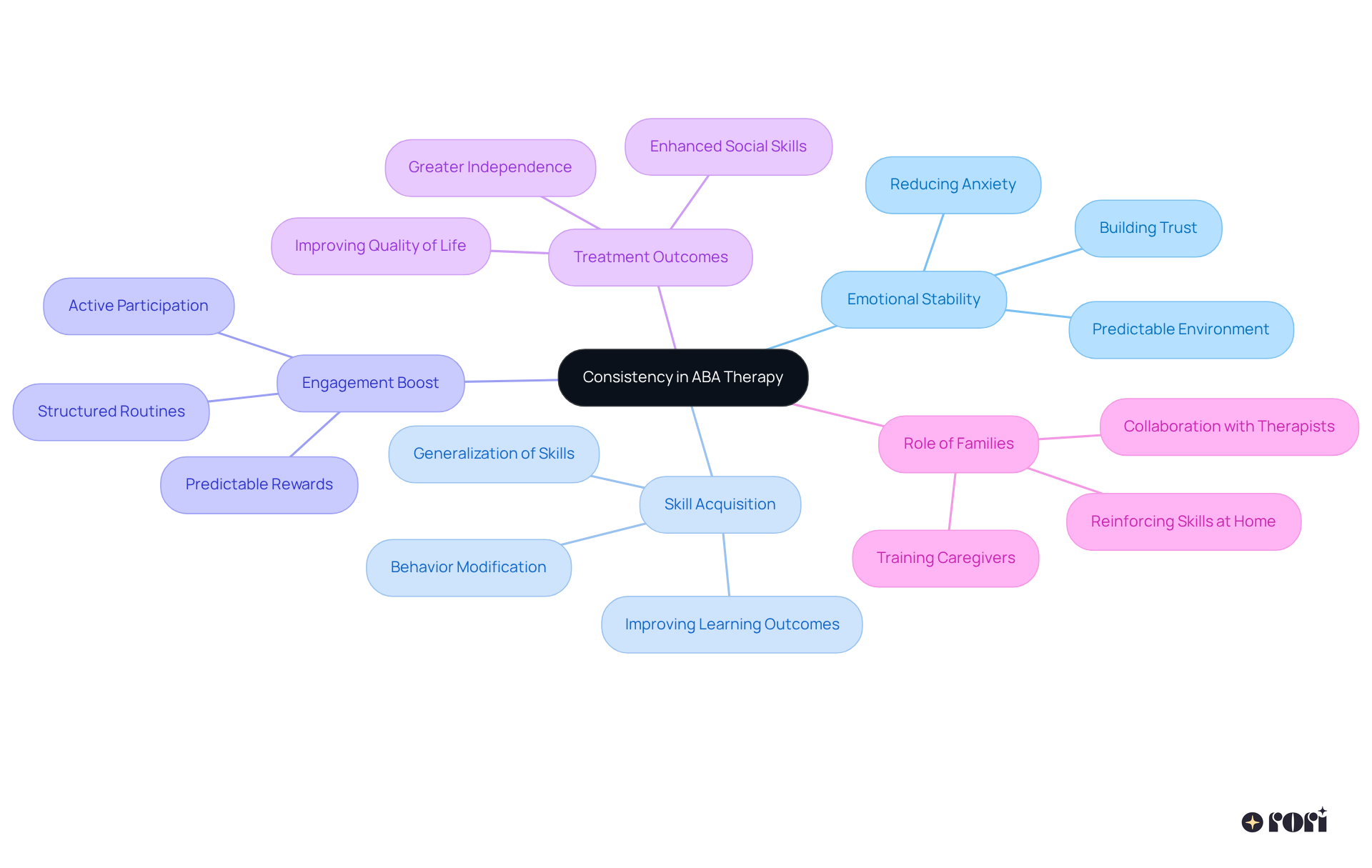
Family participation in the pairing ABA example process is essential for strengthening the skills learned during treatment. By educating parents about the pairing ABA example techniques and encouraging their involvement, we create a supportive environment that reaches beyond therapy sessions. For example, parents can use their child's favorite items and positive reinforcement at home as a pairing ABA example, ensuring a consistent learning experience. Research shows that when parents learn ABA methods, kids progress faster, benefiting from the steady reinforcement of behaviors at home. This collaborative approach not only accelerates a young person's growth but also empowers families to actively engage in their development.
Involving parents in goal-setting and maintaining open communication with therapists enhances the effectiveness of interventions. This teamwork leads to tailored strategies that meet each child's unique needs. Plus, a well-structured home environment promotes effective learning and reinforces positive behaviors. By creating a nurturing atmosphere and scheduling regular check-ins with professionals, families can significantly impact their children's success in ABA. Let’s explore this journey together, and remember, we’re here to help you every step of the way!
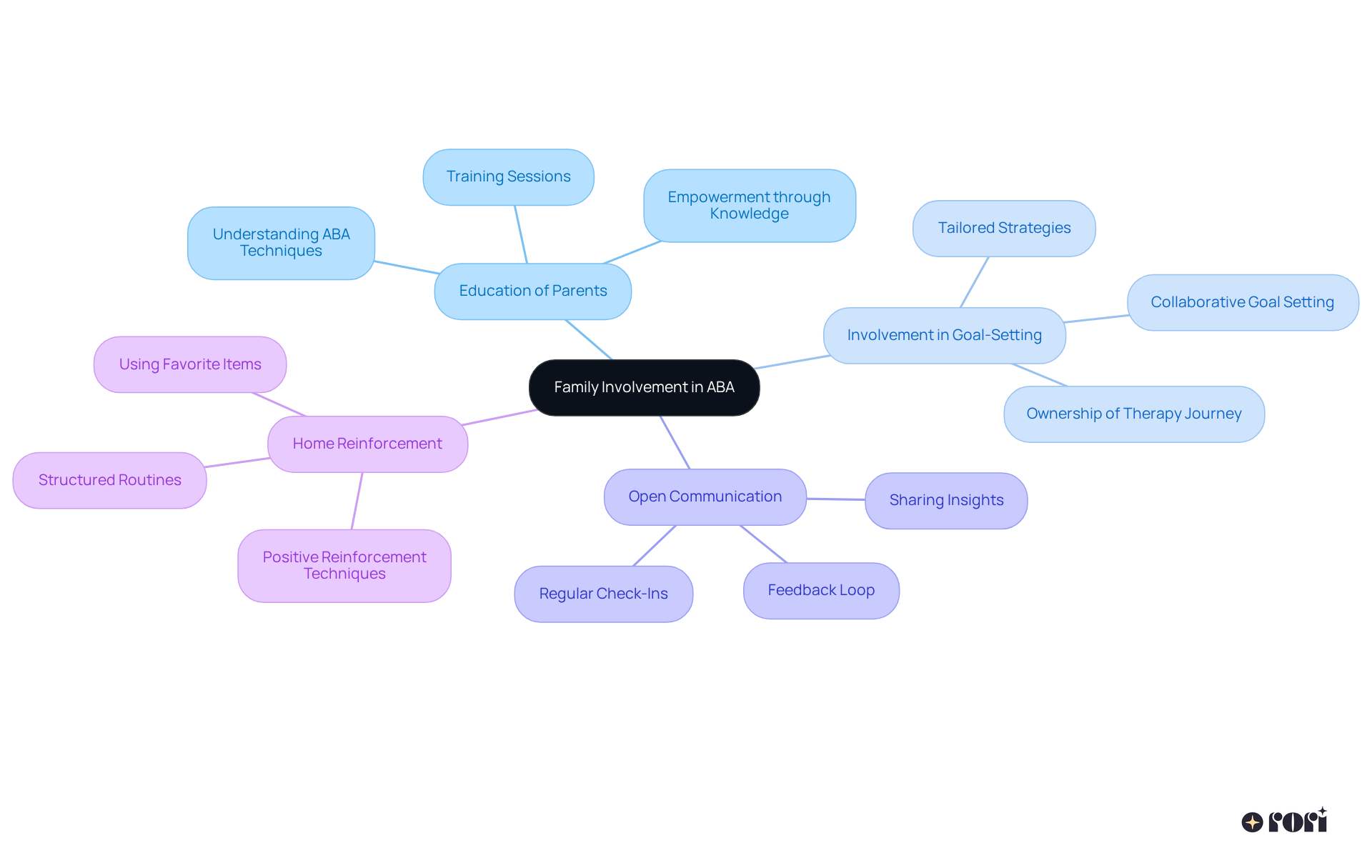
The concept of pairing ABA example focuses on using technology-enhanced tools to create fun and engaging experiences that resonate with young people's interests. Think about interactive apps, educational games, and even virtual reality experiences—all designed to grab attention and spark active participation. For instance, when kids use a tablet with interactive learning games, skill practice becomes an enjoyable activity, making those sessions lively and dynamic.
By weaving these technologies into therapy, professionals can create a more engaging environment that acts as a pairing ABA example, encouraging young individuals to jump in and learn effectively. But let’s not forget, human interaction is still super important and can’t be fully replaced by technology in therapy. The impact of these digital tools is really significant; they not only boost engagement but also help develop essential skills in ways that connect with what kids love.
As we've seen, technology can really inspire treatment by tapping into the interests of young individuals, enriching the therapeutic process. So, let’s explore this together and see how we can make learning and therapy a more enjoyable journey for our kids!

The impact of the pairing ABA example strategies in ABA treatment is truly profound! When done right, a pairing ABA example can lead to heightened engagement, reduced anxiety, and improved skill acquisition for individuals with autism. By fostering a positive therapeutic connection and creating enjoyable experiences, therapists can really boost the overall effectiveness of treatment. Research shows that children who benefit from effective pairing ABA example are more likely to actively participate in sessions, leading to better learning outcomes and a more positive therapy experience. Let’s explore this together!
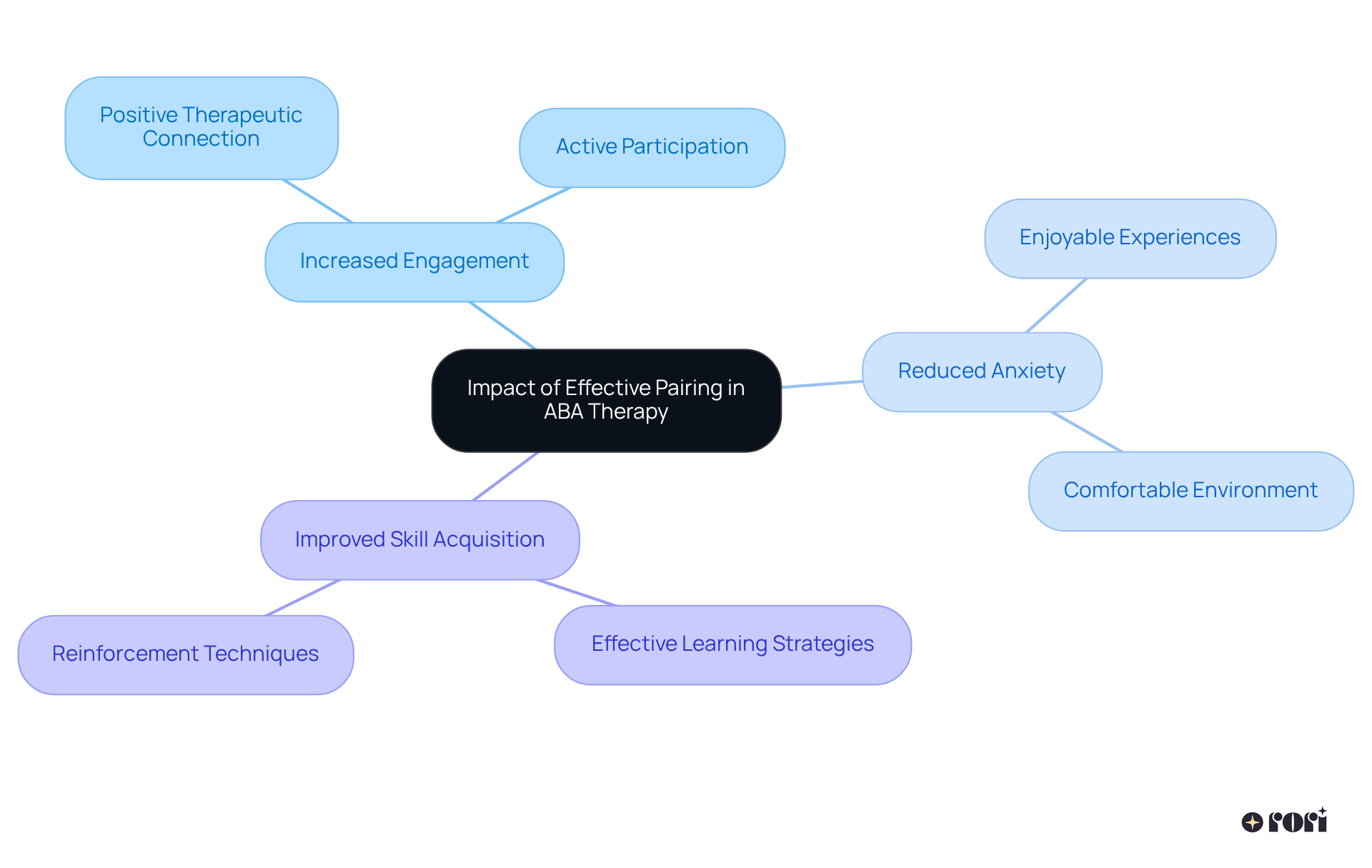
The significance of effective pairing strategies in ABA therapy is truly remarkable. By harnessing personalized approaches that resonate with each child's unique interests, therapists can create engaging and enjoyable sessions that foster a positive therapeutic relationship. This foundational element not only enhances participation but also opens the door to meaningful learning and behavior change.
Throughout this article, we’ve explored various pairing ABA examples, from presession pairing to play-based activities, positive reinforcement, and the use of preferred items. Each strategy plays a vital role in building rapport, encouraging engagement, and ultimately improving therapy outcomes. Plus, integrating family involvement and technology amplifies these efforts, ensuring children receive consistent support both in and out of therapy sessions.
In conclusion, enhancing therapy engagement through effective pairing strategies is a collective journey. It involves therapists, families, and the innovative use of technology. By prioritizing enjoyable experiences and nurturing strong connections, the potential for meaningful progress in the lives of children with autism becomes not just a possibility, but a beautiful reality. Embracing these strategies can lead to transformative outcomes, creating a more supportive and enriching environment for young individuals on their path to growth and development. Let’s explore this together!
What is the main focus of Rori Care's ABA therapy?
Rori Care's ABA therapy focuses on personalized pairing strategies that recognize each young person's unique likes and interests, crafting treatment sessions that are effective and enjoyable to build a strong therapist-client relationship.
How does Rori Care create a positive atmosphere during initial treatment sessions?
During initial treatment sessions, Rori Care emphasizes enjoyable activities with minimal demands, such as playing with favorite toys, to create a fun and inviting atmosphere that encourages active participation and boosts learning outcomes.
What is the purpose of presession pairing in therapy?
Presession pairing aims to build rapport between the therapist and the child before formal treatment begins, making it more likely for the child to engage during sessions by engaging in fun activities like playing with toys or singing songs.
How does play-based pairing enhance therapy for children?
Play-based pairing engages children through their natural love for play, creating a relaxed atmosphere that encourages skill development while making therapy feel less like a chore. It incorporates games and playful activities to boost social interactions and communication skills.
What techniques are used in play-based ABA intervention?
Play-based ABA intervention combines structured techniques like Discrete Trial Training (DTT) and Natural Environment Teaching (NET) with playful activities, using methods like incidental teaching during play to reinforce skills seamlessly.
How can parents support their child's learning at home?
Parents can support their child's learning by creating a fun environment at home with toys and activities tailored to their child's interests, reinforcing the skills developed during therapy sessions.
What is the overall impact of pairing ABA examples in therapy?
The pairing ABA example in play-based treatment transforms the therapy experience into a dynamic and enjoyable one, significantly enhancing children's involvement and skill acquisition, particularly for those with autism.